Gigaset S675IP User manual

s
Gigaset
Gigaset S675IP
BA S675IP.indd 3BA S675IP.indd 3 27.02.2008 15:42:32 Uhr27.02.2008 15:42:32 Uhr

1
The handset at a glance
Gigaset S675 IP / ALGERIAN eng / A31008-M1915-A751-1-3T19 / overview.fm / 27.10.08
Version 4, 16.09.2005
The handset at a glance
Handset keys
1 Display in idle status (example)
2Charge status of the batteries
eVU(1/3 charged to fully charged)
= flashes: battery almost flat
eVUflashes: battery charging
3Display keys (page 29)
4Message key
Opens calls and message lists
Flashes: new message or new call
5End call key, On/Off key
End call, cancel function, go back one menu
level (press briefly), back to idle status
(press and hold), activate/deactivate
handset (press and hold in idle status)
6Hash key
Keypad lock on/off (press and hold,
page 28)
Switch between upper/lower case letters
and digits for text input (page 131)
7Call-by-call list key (not for VoIP)
Open call-by-call list
8Microphone
9Recall key
Fixed line network:
enter flash (press briefly)
insert a pause (press and hold)
VoIP: enter Flash (adjustable, page 108)
10 Star key
Idle status: ringer tones on/off
(press and hold)
Fixed line network: switch between
dial pulsing/touch tone dialling
Editor: open special characters table
11 Key 1 (press and hold)
Call the network mailbox or answer machine
12 Connection socket for headset (page 18)
13 Talk key
Accept call, open last number redial list
(press briefly in idle status), select connec-
tion type and start dialling (press briefly/
press and hold after entering the number,
page 24)
SMS editor: send SMS
14 Handsfree key
Change between speaker/handsfree mode
Lights up: handsfree talking activated
Flashes: incoming call
15 Control key (page 29)
16 Eco mode activated (page 18)
17 Signal strength
Ò Ñ i (low to high)
| flashes: no reception
18 Answer machine icon
Answer machine switched on;
Flashes: answer machine is recording a
message or is being operated by another
internal party
2
3
5
4
6
7
15
14
11
9
10
8
1
13
нV
INT 1
15.01.08 09:45
?SMS
12
17
16
18

2
The base station at a glance
Gigaset S675 IP / ALGERIAN eng / A31008-M1915-A751-1-3T19 / overview.fm / 27.10.08
Version 4, 16.09.2005
The base station at a glance Base station key
1Paging key
Lights up:
LAN connection active (phone is connected
to router)
Flashes:
data transfer to LAN connection
Press briefly:
start paging (page 74), display IP address on
handset
Press and hold:
set base station to registration mode
(page 73)
1

3
Contents
Gigaset S675 IP / ALGERIAN eng / A31008-M1915-A751-1-3T19 / S675-IP_LBA_ALG_ENIVZ.fm / 27.10.08
Version 4, 16.09.2005
Contents
The handset at a glance . . . . . . . 1
The base station at a glance . . . . 2
Safety precautions . . . . . . . . . . . . 6
Gigaset S675 IP –
more than just a telephone . . . . . 8
VoIP – making calls via
the Internet . . . . . . . . . . . . . . . . . . 9
Gigaset HDSP – telephony with
brilliant sound quality . . . . . . . . . 9
First steps . . . . . . . . . . . . . . . . . . . 10
Pack contents . . . . . . . . . . . . . . . . . . . 10
Setting up the handset for use . . . . . . 10
Installing the base station . . . . . . . . . 12
Connecting the base station . . . . . . . 13
Making settings for VoIP telephony . . 15
Belt clip and headset . . . . . . . . . . . . . 18
ECO DECT:
reducing the transmission power
and power consumption . . . . . . 18
Menu trees . . . . . . . . . . . . . . . . . . 19
Phone menu . . . . . . . . . . . . . . . . . . . . 19
Web configurator menu . . . . . . . . . . . 23
Making calls with VoIP and
the fixed line network . . . . . . . . 24
Making an external call . . . . . . . . . . . 24
Ending a call . . . . . . . . . . . . . . . . . . . . 25
Accepting a call . . . . . . . . . . . . . . . . . 25
Calling Line Identification . . . . . . . . . 26
Handsfree talking . . . . . . . . . . . . . . . . 28
Muting the handset . . . . . . . . . . . . . . 28
Operating the handset . . . . . . . . 28
Activating/deactivating the handset . 28
Activating/deactivating the
keypad lock . . . . . . . . . . . . . . . . . . . . . 28
Control key . . . . . . . . . . . . . . . . . . . . . 29
Display keys . . . . . . . . . . . . . . . . . . . . 29
Reverting to idle status . . . . . . . . . . . . 30
Menu guidance . . . . . . . . . . . . . . . . . 30
Correcting incorrect entries . . . . . . . . 30
Network services . . . . . . . . . . . . 31
Anonymous calling –
withholding caller ID . . . . . . . . . . . . . . 31
Further network services in the
fixed line network . . . . . . . . . . . . . . . . 31
Further network services for VoIP . . . . 33
Using the directory and lists . . 35
Directory/call-by-call list . . . . . . . . . . . 35
Last number redial list . . . . . . . . . . . . 39
Opening lists with the
message key . . . . . . . . . . . . . . . . . . . . 39
Making cost-effective calls . . . . 42
SMS (text messages) . . . . . . . . . 43
Writing/sending an SMS . . . . . . . . . . . 44
Receiving an SMS . . . . . . . . . . . . . . . . 46
Notification by SMS . . . . . . . . . . . . . . . 48
SMS mailboxes . . . . . . . . . . . . . . . . . . 49
Setting SMS centres . . . . . . . . . . . . . . 50
SMS on a PABX . . . . . . . . . . . . . . . . . . 50
Activating/deactivating SMS function . 50
SMS troubleshooting . . . . . . . . . . . . . 51
Operating the base station
answer machine . . . . . . . . . . . . 52
Operation via the handset . . . . . . . . . 52
Activating/deactivating call screening 56
Setting up the answer machine . . . . . 57
Configuring the network mailbox
for fast access . . . . . . . . . . . . . . . . . . . 58
Operating when on the move
(remote operation) . . . . . . . . . . . . . . . 58
E-mail notifications . . . . . . . . . . 60
Opening the incoming e-mail list . . . . 60
Viewing the message header of
an e-mail . . . . . . . . . . . . . . . . . . . . . . . 61
Viewing an e-mail sender's
address . . . . . . . . . . . . . . . . . . . . . . . . 62
Messenger . . . . . . . . . . . . . . . . . 63
Establishing a connection,
going online . . . . . . . . . . . . . . . . . . . . 64
Changing/checking your personal status,
going offline . . . . . . . . . . . . . . . . . . . . 65
Opening the buddy list . . . . . . . . . . . . 66
Receiving messages . . . . . . . . . . . . . . 67
Writing and sending messages . . . . . . 68

4
Contents
Gigaset S675 IP / ALGERIAN eng / A31008-M1915-A751-1-3T19 / S675-IP_LBA_ALG_ENIVZ.fm / 27.10.08
Version 4, 16.09.2005
Calling a buddy . . . . . . . . . . . . . . . . . . 69
Self-help with errors . . . . . . . . . . . . . . 69
Using the network mailbox . . . . 70
Activating/deactivating the network mail-
box, entering numbers . . . . . . . . . . . . 70
Configuring the (network) mailbox for fast
access . . . . . . . . . . . . . . . . . . . . . . . . . 71
Listening to messages on the network
mailbox . . . . . . . . . . . . . . . . . . . . . . . . 72
Using several handsets . . . . . . . . 73
Registering handsets . . . . . . . . . . . . . 73
De-registering handsets . . . . . . . . . . . 74
Locating a handset ("paging") . . . . . . 74
Changing the base station . . . . . . . . . 74
Changing a handset's
internal number . . . . . . . . . . . . . . . . . 74
Changing the name of a handset . . . . 75
Making internal calls . . . . . . . . . . . . . 75
Using a handset as a
room monitor . . . . . . . . . . . . . . . . . . . 76
Handset settings . . . . . . . . . . . . . 78
Changing the display language . . . . . 78
Setting the display . . . . . . . . . . . . . . . 78
Setting the screensaver . . . . . . . . . . . 78
Setting the display backlight . . . . . . . 79
Shortcuts for functions and
numbers . . . . . . . . . . . . . . . . . . . . . . . 79
Activating/deactivating
auto answer . . . . . . . . . . . . . . . . . . . . 80
Changing the handsfree/
earpiece volume . . . . . . . . . . . . . . . . . 80
Changing ringer tones . . . . . . . . . . . . 81
Activating/deactivating muting
for the first ringer tone . . . . . . . . . . . . 82
Activating/deactivating
advisory tones . . . . . . . . . . . . . . . . . . 82
My stuff . . . . . . . . . . . . . . . . . . . . . . . 82
Setting the alarm clock . . . . . . . . . . . . 83
Setting an appointment (calendar) . . 84
Displaying missed appointments
and anniversaries . . . . . . . . . . . . . . . . 85
Setting your own area code . . . . . . . . 85
Restoring the handset to the factory
settings . . . . . . . . . . . . . . . . . . . . . . . . 86
Base station settings . . . . . . . . . 86
Protecting against unauthorised
access . . . . . . . . . . . . . . . . . . . . . . . . . 86
Restoring the base station to the
factory settings . . . . . . . . . . . . . . . . . . 87
Activating/deactivating
music on hold . . . . . . . . . . . . . . . . . . . 87
Activating/deactivating
repeater mode . . . . . . . . . . . . . . . . . . 87
Set default connection . . . . . . . . . . . . 88
Updating the base station firmware . . 88
Making VoIP settings . . . . . . . . . 89
Using the connection assistant . . . . . . 89
Changing settings without the
connection assistant . . . . . . . . . . . . . . 89
Setting the phone's IP address in
the LAN . . . . . . . . . . . . . . . . . . . . . . . . 89
Activating/deactivating display
of VoIP status messages . . . . . . . . . . . 90
Checking the base station
MAC address . . . . . . . . . . . . . . . . . . . . 91
Operating the base station
on the PABX . . . . . . . . . . . . . . . . 91
Setting recall . . . . . . . . . . . . . . . . . . . . 91
Setting pauses . . . . . . . . . . . . . . . . . . . 91
Switching temporarily to
tone dialling (DTMF) . . . . . . . . . . . . . . 91
Web configurator –configuring
phone via PC . . . . . . . . . . . . . . . 92
Connecting PC with
Web configurator . . . . . . . . . . . . . . . . 92
Logging in, setting the Web configurator
language . . . . . . . . . . . . . . . . . . . . . . . 93
Logging off . . . . . . . . . . . . . . . . . . . . . 93
Structure of the Web pages . . . . . . . . 94
Opening Web pages . . . . . . . . . . . . . . 95
Setting the phone with
Web configurator . . . . . . . . . . . . . . . . 96
IP Configuration . . . . . . . . . . . . . . . . . 96
Configuring telephone
connections . . . . . . . . . . . . . . . . . . . . . 98
Optimising voice quality for
VoIP connections . . . . . . . . . . . . . . . . 103
Table of contents
Other Gigaset Telephone manuals
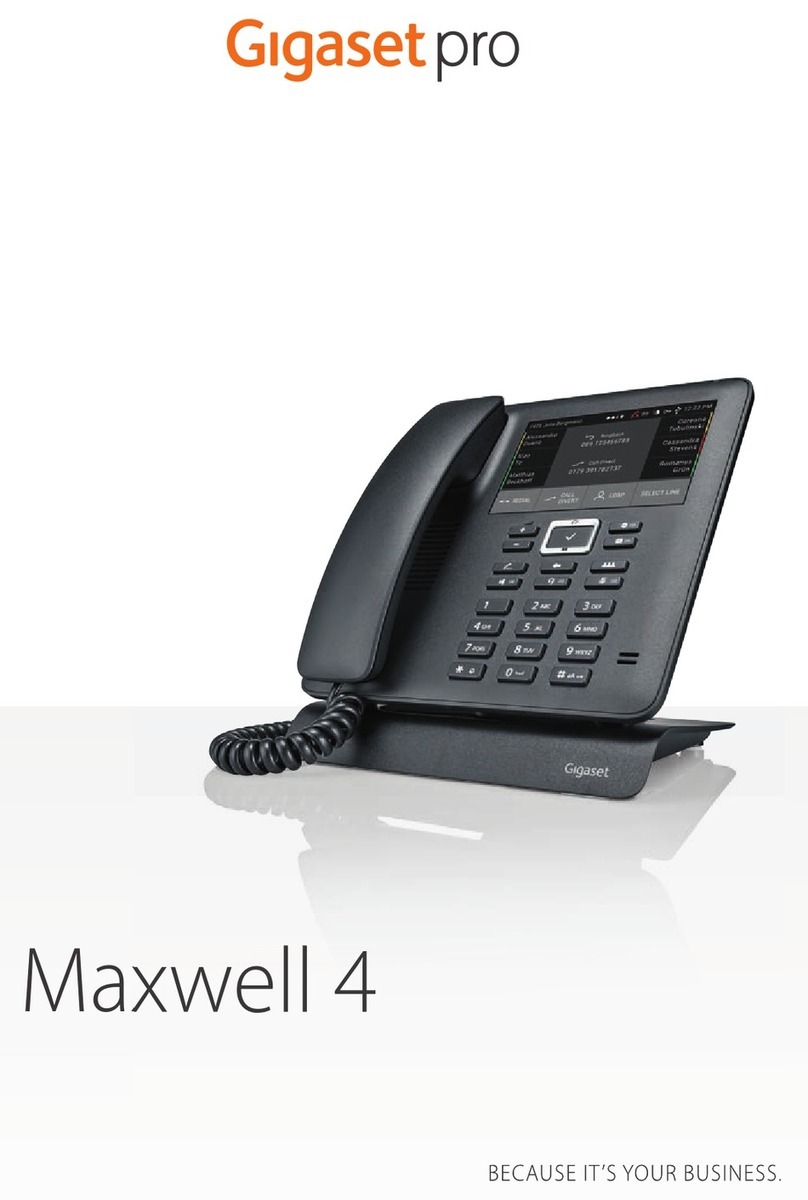
Gigaset
Gigaset pro Maxwell 4 User manual

Gigaset
Gigaset 5040 User manual
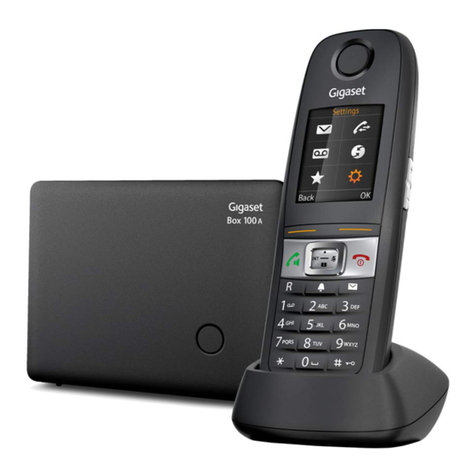
Gigaset
Gigaset E630 User manual

Gigaset
Gigaset 5015 User manual
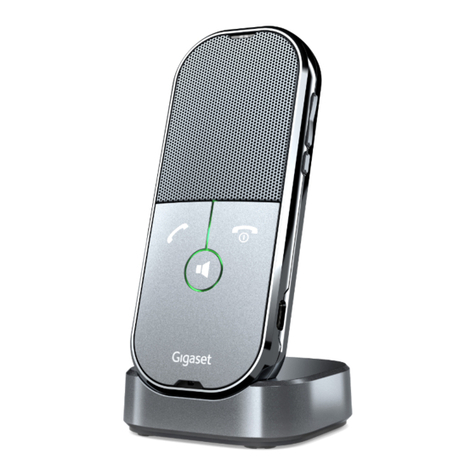
Gigaset
Gigaset ION User manual

Gigaset
Gigaset A400 User manual

Gigaset
Gigaset E560HX User manual
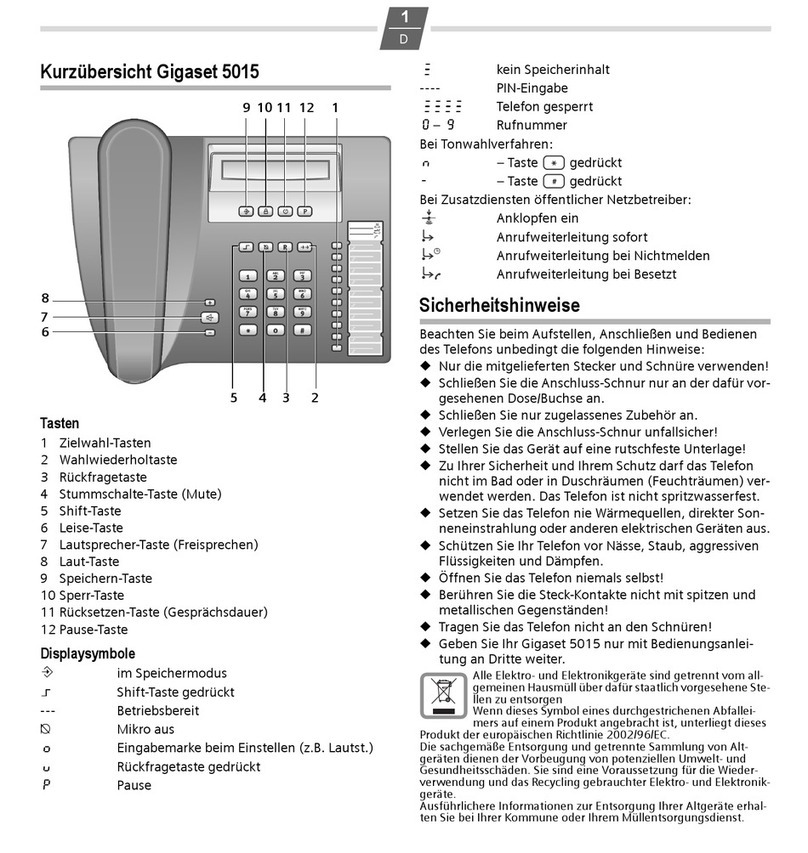
Gigaset
Gigaset 5015 User manual
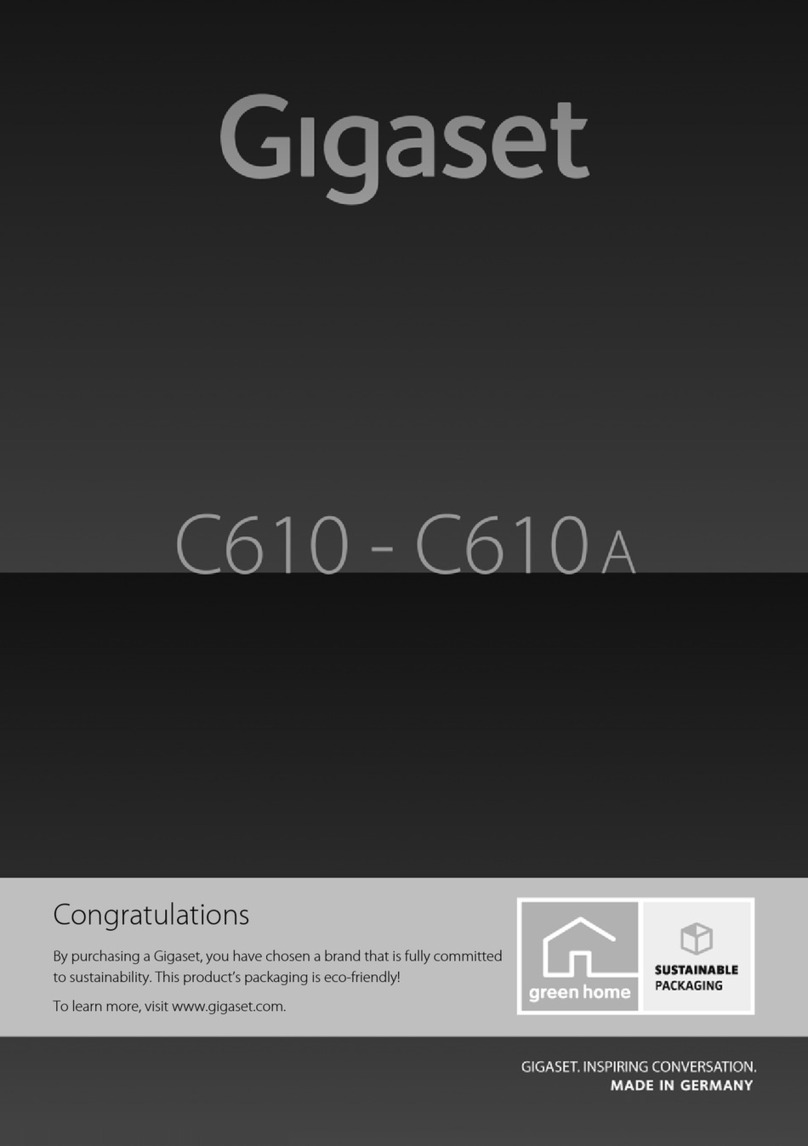
Gigaset
Gigaset C610A User manual

Gigaset
Gigaset T300PRO User manual
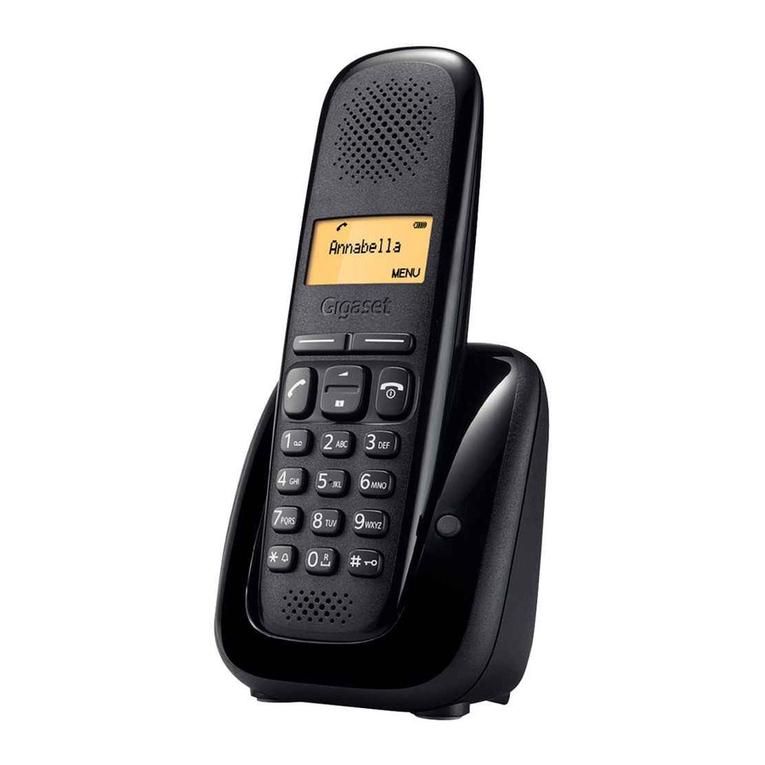
Gigaset
Gigaset A150 User manual
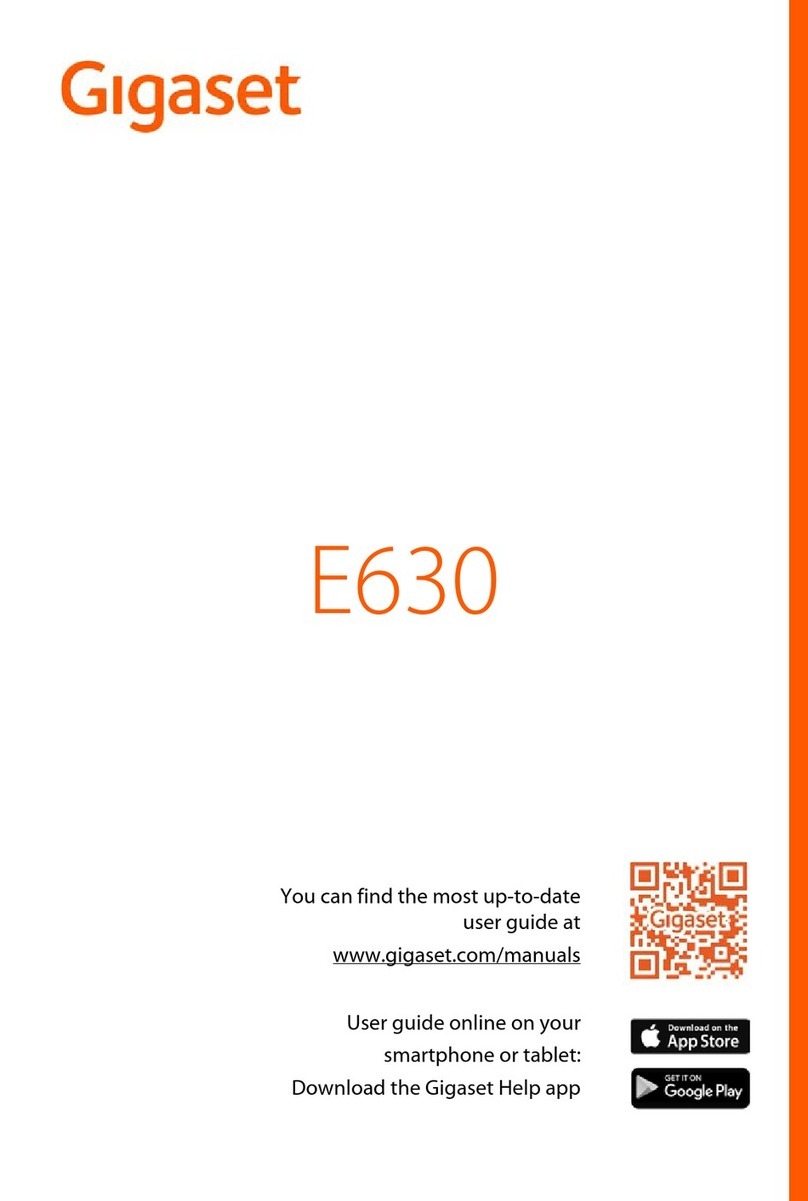
Gigaset
Gigaset E630 User manual

Gigaset
Gigaset DA310 Installation guide

Gigaset
Gigaset AL110 User manual

Gigaset
Gigaset T640 PRO User manual
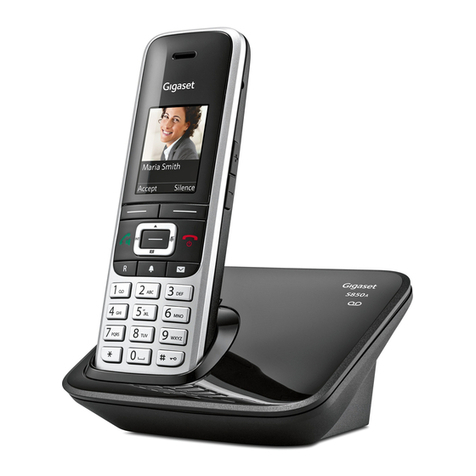
Gigaset
Gigaset S850A User manual
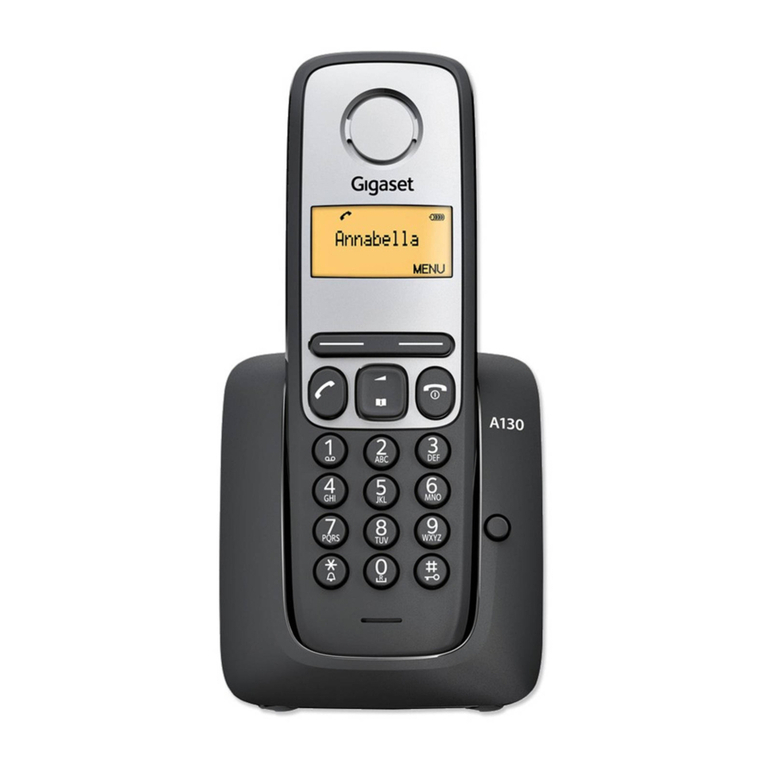
Gigaset
Gigaset A130 User manual
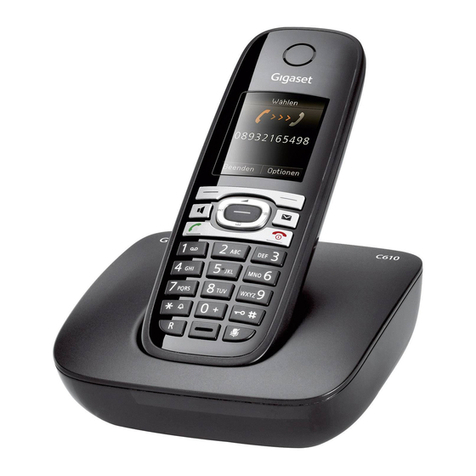
Gigaset
Gigaset C610 User manual
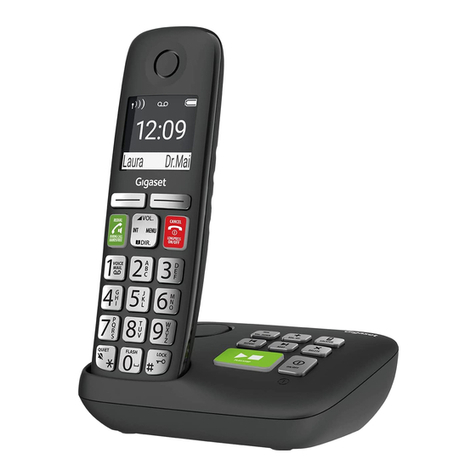
Gigaset
Gigaset E295 User manual

Gigaset
Gigaset 5040 User manual





















